While Ford’s domestic sales stalled in 2022 – partly due to the electronic chip shortage which hampered the entire sector – its EV sales doubled to make it the US’s second-largest EV automaker behind Tesla.
New models include the all-electric Mustang Mach-E and even an electric version of its iconic F-150 pickup truck, the F-150 Lightning.
Ford was looking for ways to increase its reach around the globe and Formula 1’s recent surge inevitably made it an attractive proposition.
As Ford CEO Jim Farley said at the Red Bull livery launch on Friday: “Around the world, we have almost 200,000 employees. And we are really excited to engage a whole new generation of customers with our electric vehicles.”
The Blue Oval had been evaluating F1 for some time, but the category’s current hybrid rules proved a stumbling block for most interested manufacturers.
While a technological marvel, the extreme efficient MGU-H motor recovering the car’s exhaust gases also proved extremely expensive to develop and bore little relevance to road car technology.
It’s been known that Volkswagen, which will buy into Sauber with its Audi brand, felt the MGU-H was a stumbling block in its bid to join F1 and it put off Ford as well.
After lengthy negotiations the FIA finally ratified F1’s new engine regulations for 2026 last August; rules which were specifically designed to make the 1,000+ bhp hybrid power units both more cost-effective and more ecologically sustainable.
The MGU-H is gone and instead, the MGU-K will do more of the heavy lifting, recovering up to three times the energy from the brakes. F1 is also moving to sustainable fuels and the new rules should help reduce the fuel burn per grand prix.
Red Bull Ford Powertrains logo
Photo by: Red Bull Racing
The 2026 power unit rules reset therefore proved a once in a generation opportunity for a manufacturer to enter F1 on its own terms and on a relatively level playing field, given all marques will need to develop a new power unit and the head start for existing manufacturers won’t be this small again for an entire cycle.
Six manufacturers have registered to supply a new power unit from 2026, which includes not only new boys Audi and Red Bull – Ford but also Red Bull’s existing partner Honda, which re-entered F1 quicker than it could pull out.
Ford’s global director of motorsport Mark Rushbrook explained Ford’s case study of what a sensible Formula 1 programme could look like started over two years…
Click Here to Read the Full Original Article at Motorsport.com – Formula 1 – Stories…

